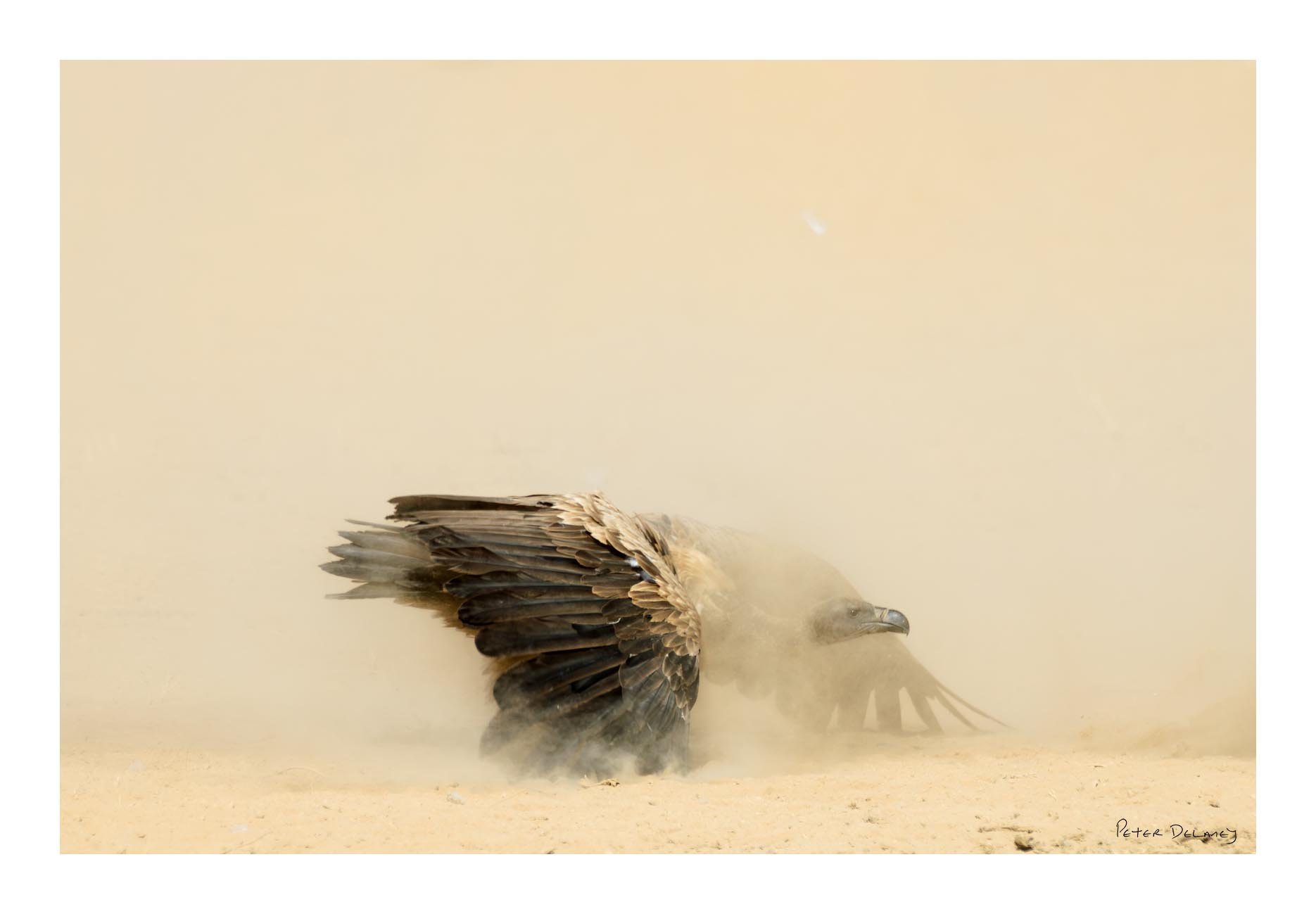"Why Did ‘The Gladiator’ Vulture Photo Win Wildlife Photographer of the Year?"
How a Single Frame of Chaos in the Kalahari Became an Iconic Wildlife Award Winner"
Award-winning photographer Peter Delaney shares the real story behind this iconic fine art wildlife print, shot in Namibia’s Kalahari Desert.
The Gladiator | Open Edition Fine Art Print
Let Chaos Speak — A Fine Art Wildlife Print That Captures the Brutal Beauty of Survival
Let Chaos Speak — A Fine Art Wildlife Print That Captures the Brutal Beauty of Survival
Where was the ‘Gladiator’ vulture photo taken?
This image was taken in Kgalagadi Transfrontier Park, along the Nossob dry riverbed, during one of the harshest droughts in recent memory. It was late October, and the rains had yet to come. Carcasses of eland lay scattered across the sand, a grim reminder of what drought does to even the hardiest creatures.
Nearby, lions rested under the trees, their bellies full. But for the vultures, survival was far from certain. The air was dry, thick with dust and heat. Dozens of White-backed Vultures descended in a frenzy, fighting violently for scraps, their wings slashing through the air, talons clawing, feathers flying.
The Gladiator
Raw. Wild. Unfiltered.
“The vultures transformed the drought-stricken riverbed into an arena. Claws slashed. Beaks stabbed. Wings struck like broadswords through the ochre haze. I fired shot after shot, guided only by instinct - the dust so thick I could barely see my lens.
Then, as suddenly as it began, the chaos parted. There he stood: wings spread like a conqueror’s cloak, eyes burning with primal triumph. No director could stage this drama. No painter could capture its brutal truth. This was raw nature - beautiful, terrifying, and utterly uncompromising”
Clash in the Dust
Art that Speaks. Own a Moment of Pure Wild Power
Behind the Moment
I had waited years for a moment like this—midday, backlit chaos, and absolute unpredictability. I had positioned myself near the carcass, hoping to capture vulture behaviour at its most dramatic.
The heat was intense, the air electric with conflict. More than 60 White-backed Vultures, two Lappet-faced Vultures, and even a Bateleur Eagle and Lanner Falcon circled above or waited in nearby trees.
The dust thrown up by the fighting birds made it nearly impossible to focus. I was photographing with more hope than certainty, blindly trusting that my instinct would guide the lens. When I reviewed the files later, I knew I had captured something wild, unrepeatable—and deeply real.
For Collectors of the Unforgettable
Prints with Punch. Art with Soul.
Behind the Lens: Capturing the Decisive Moment That Won Global Acclaim
"The gear was pushed to its limits—just like me."
That day in the Kalahari, my Nikon D2xs (the best action camera of its era) and trusty 200-400mm f/4 with a 1.4x adapter barely kept up. Dust caked the lens. Heat warped the air. At 1/1000 sec, f/8, ISO 400, I was shooting blind into a storm of wings and rage—no time to check focus or exposure.
But sometimes, old tech and instinct align. When the dust cleared, I saw it: a single frame where light, motion, and raw survival converged. No focus tracking. No mirrorless previews. Just a decade-old sensor capturing what eyes alone couldn’t: the millisecond a vulture became a gladiator.
Gear Notes for Photographers:
Body: Nikon D2xs (2006 flagship, 12.4 MP)
Lens: Nikkor 200-400mm f/4 + 1.4x TC (effectively 560mm f/5.6)
Settings: 1/1000 sec | f/8 | ISO 400
Challenge: Shooting backlit action with limited dynamic range
"Proof that vision outweighs specs. The shot that mattered wasn’t in the manual."
Why Colour?
Black and white might have simplified the chaos, but colour was essential here.
The golden Kalahari light, the warm tones of the dust, and the subtle variations in the vultures’ plumage all create a richer, more immersive experience. This moment wasn’t quiet or composed—it was searing, loud, and physical. The colour reflects that truth.
What awards did this vulture photo win?
This photograph has earned major global recognition:
🏆 Wildlife Photographer of the Year – Animal Portraits
🏆 International Photography Awards (IPA) – Wildlife
📖 Published by National Geographic
Its success lies in its authenticity, fine art tonality, and the emotional force it carries. The vultures aren’t just birds—they are sculpted symbols of survival.
What Print Sizes and Finishes Are Available?
The Gladiator is available as an open edition, made to order in a range of premium fine art finishes:
✅ Loose archival print on Hahnemühle Photo Rag
✅ Acrylic glass print (slimline aluminium frame: gold, black, white, or silver)
✅ Canvas print (solid wood stretcher; optional floating frame in black oak, brown elder, white maple, or natural)
Shipped Free Worldwide




